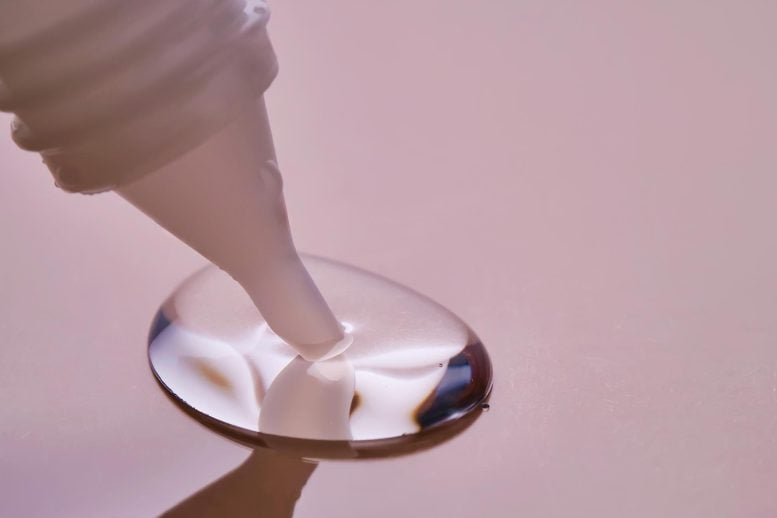
“Hard-soft electroadhesion” is a new method enabling the attachment of various hydrogels to metals using an electric current, as detailed in ACS Central Science. This versatile and reversible technique can be applied to a broad range of materials, including food items and different metals.
A novel electroadhesion process allows for the easy and reversible attachment of hydrogels to metals using electricity, effective on a variety of materials from food to metals.
How would you stick a slice of banana to a sheet of copper? Until a few months ago, you couldn’t. But a new discovery called “hard-soft electroadhesion” enables chemists to stick almost any hydrogel to almost any metal, using nothing but an electric current. And you can unstick the materials simply by reversing the current.
Recently reported in ACS Central Science, this astonishingly general phenomenon works with a wide variety of gels (including fruits, vegetables, meat, and fish) and conductors (including metals and graphite). Join our host George as he attempts to replicate electroadhesion in his basement and tries to discover what — if anything — this remarkable phenomenon shares with super glue.
Video Transcript:
I’m gonna show you a chemistry magic trick. This is a banana, this is a DC power supply, and these are copper electrodes, because I am testing what seems like a huge new chemistry breakthrough that was just published a few months ago.
Now, let’s see. Yeah, that just came off. So did that. It didn’t work, so I’m just gonna give up.
I’m just kidding, I’m gonna crank the voltage up as high as it will go. There’s 0.007 amps running through that banana right now.
And this time after passing a tiny bit of current through this banana… What if I kind of- Okay that, so that holds, look at that. That holds.
This is called electroadhesion. Gluing things together using only electrical current. And it’s not just bananas. Supposedly you can do this with jello too. Pretty good. Do I need the knife? Could this just pop out? Oh, yeah, look at that.
That’s 0.055 amps flowing through this block of jello. Oh my god, it’s actually bubbling the bottom of the jello. This was not mentioned in the paper at all. That’s so cool. I can hear it.
I got so excited that I forgot to set a timer. So who knows how long this has been going on.
All right, here we go. And again, one side sticks, the other does not. Okay? Bottom did not stick at all. This is reasonably well stuck on like you can see.
I’m trying to get it off and it’s not coming off. I mean, but that’s not even the magic part. That is stuck. The magic part comes when I reverse the polarity. Red’s going on the bottom. So now the current is flowing the opposite direction, and the adhesion is undone. So that came right off. That was the part that was stuck. before reversible electroadhesion, magic.
So then I had to test it with graphite electrodes and that worked. And then graphite and a banana and that worked. Okay, this is definitely stronger than it was upstairs.
And then I tried a clear gel. And now it’s just straight-up foaming. That didn’t really work. Ah. But it did give an interesting result. I am pretty sure it was not blue before. Yeah, look at that. This is before and this is after.
Then my adhesion research got a little sidetracked when I learned that hairspray is basically aerosolized Elmer’s glue. So I had to test that out. So to test my hairspray naturally I bought a head. Let’s give her some less creepy lighting. There we go. Nope, that’s more creepy. Couple sprays have diluted Elmer’s. Oh, yeah, that’s pretty good. This one is pretty floppy, this is pretty rigid. Now is it good hairspray? No. Does it work? Yes.
Okay, back to electroadhesion. This video is about electroadhesion. Yes, yes. I had to go bigger. It’s working. Wow. Again, one side didn’t stick, but the other side…
No. No. I don’t believe this. Are you not entertained? Oh, it’s breaking, it’s breaking, it’s breaking. Ah. Oh my god, that was incredible.
Man, look at that jiggle. Do this in slow motion. Okay, now I didn’t numerically test the strength of this joint, but this jello thing weighs at least a pound. So I think I can confidently say that I replicated the main finding of this paper. And it is a weird main finding. Like we’re taking a block of jello and we’re gluing it to a piece of copper using no actual glue, but only using electrons, electricity.
So how does this thing, which by the way, is called electroadhesion hard-soft work? And for that matter, how does regular glue even work? To find out, I picked a glue at random, Super Glue, and I Googled it. And I quickly found a really bad explanation repeated all over the internet. So we’re gonna start there, with that terrible explanation. Are you ready? Here it is.
Super Glue is usually ethyl-2-cyanoacrylate, this molecule right here. Now, these two functional groups mean that this carbon is actually electron deficient, which means that this carbon is susceptible to nucleophilic attack, by let’s say water. That gives you this molecule, which then goes on to react with another molecule of ethyl-2-cyanoacrylate.
Now at this point you’ve got two monomers which react to give you a dimer. Then that dimer goes on to react with another molecule of ethyl-2-cyanoacrylate, and that gives you a trimer. Then that trimer reacts with another molecule and you get the idea of where I’m going with this, right? That happens over and over and over again until you get a polymer, poly ethyl cyanoacrylate.
So fun fact, I had COVID while shooting this scene, and that made me absolutely botch every polymer structure in this video. Am I blaming COVID? Yes I am. This is the actual correct structure for polyethyl cyanoacrylate. You can see that in my structure I added an extra carbon for no reason whatsoever, and I put the N on the top like a mathematician instead of on the bottom like a chemist.
So overall, you’ve gone from lots of small molecules in this tube, to fewer larger molecules, polymers. Now these polymers can’t move around because everything around them is also a polymer. So on the macro scale, you’ve got hardened glue. These are stuck. Did you notice that in that explanation we learn a lot about how super glue sticks to itself, but we learn nothing about how super glue sticks to something else? And sticking to something else is the whole point of a glue. So really it’s actually explaining nothing.
So I switched over from looking at the internet to looking at textbooks, and I found, yeah, still nothing about how super glue sticks to other stuff. But I did find one-half sentence in the handbook on adhesives that I found particularly intriguing. And that half sentence is, “Ice will adhere to almost any surface.”
Ice. And I had this moment of like, yeah, of course it will. Like look, ice cube tray. Do these ice cubes just come out on their own? No, they do not. You have to crack the tray to release them because the ice adheres to the tray.
So does that mean that water is a glue? Hear me out on this, okay? Water starts off as a liquid, which is not sticky, doesn’t stick to stuff. But then you apply it to two materials and you crank the temperature down, which I’m doing here with my fancy cold plate. And as the water freezes, it hardens, which adheres the two materials together.
Here on the right is water and here on the left is super glue. And both of these things are applied in liquid form, they harden, and when they harden, they adhere the two materials together. Glues typically don’t harden by freezing, they harden in other ways, but that’s really the main difference.
As a chemist, I have always known that individual water molecules are sticky because of hydrogen bonding. The hydrogen bond to DNA, the hydrogen bond to proteins, they hydrogen bond to surfaces all around us. And in fact, if you really wanna dry a surface, you have to put a lot of energy into making those last few water molecules evaporate.
But I did not realize that when you freeze water, what you’re really doing is locking all those molecules in place. So not only does the water stick to the surface, it also sticks to itself. And that is exactly what almost all real glues do.
Okay, so I will pat myself on the back for that epiphany, but it doesn’t explain what super glue is actually doing. Like, yeah, with water, it’s hydrogen bonding, but what is super glue doing?
So I just went out and bought some super glue for this video only to discover that my next clue was right here the whole time on the back of the package. I could have seen this weeks ago. It says, “Not recommended for use on polyethylene or polypropylene plastic.”
So I got some polypropylene and we are gonna see what happens when you try and super glue it. (upbeat music) Eight, nine. Here we have two pieces of polypropylene bonded together by super glue. Let’s see what happens. Yeah, it doesn’t hold at all. Wow, that was shockingly easy to unstick.
This is an interesting clue. And to understand the clue, let’s look at the chemical structures of these two polymers. Chemically, these are boring. It’s just carbon-carbon, single bonds and carbon-hydrogen single bonds. And that means that the only way for super glue to interact with these two polymers is via something called van der Waals forces.
Now, van der Waals forces or interactions are defined by what they are not. They’re not covalent bonds, they’re not ionic bonds and they are not hydrogen bonds. They’re all the other ways that two different molecules can interact with each other. And crucially, they are the weakest type of intermolecular attraction possible.
So now we’ve got two facts to consider. Fact number one is that polyethylene and polypropylene can only be bonded using van der Waals interactions. Fact number two is that super glue does a bad job of bonding polyethylene and polypropylene. Taken together, these facts mean that super glue cannot rely very much on van der Waals forces to do what it does, because if it did, it would be good at bonding these things.
But if that’s true, then what does it rely on? Covalent bonds, ionic bonds, hydrogen bonds. Is there some other mysterious bond out there that I don’t know about? Is it magic?
So I banged my head against the wall of Google Scholars some more, until I finally found these two papers from 2021 and 2023. Now, notice that that’s really recent. And this paper from 2021 states and I quote, “Despite their commercial use,” and by commercial they mean super glues, “the exact bonding mechanism is virtually unknown.”
So it wasn’t just me, nobody knew how super glue worked until these scientists figured it out. And what they did is really interesting. They spun very thin films of super glue onto metal or metal oxide plates and then used a bunch of spectroscopic techniques to look very specifically at the interface between the two materials.
And they found two interesting things. First, that super glue hydrogen bonds between itself and the surface that it is in contact with. Now, this is not all that shocking, because on super glue we have lots of these carbonyl groups. And on surfaces like this metal oxide surface, we usually have lots of hydroxyl groups. So you would expect some hydrogen bond formation. But the second thing that they found is an absolute stunner.
So what’s happening here on the top section is basically super glue is losing this ethoxy group and forming a carboxylate group. And then what happens is down here, the metal oxide surface loses a hydroxyl group, which leaves a positively charged metal atom right in the lattice here. And that positively charged metal atom interacts with a negatively charged carboxyl group forming, and this is the stunning part, an ionic bond. And generally ionic bonds are the strongest type of bonds.
So I wonder how much of super glue strength comes from this. Yeah, hi, future me again. So this structure is also wrong. I was looking at this figure, which shows the newly discovered ionic bond. Now, if I had been paying attention, I would’ve noticed that this wing-like bat structure is not meant to be the repeating unit of poly ethyl cyanoacrylate. But I wasn’t paying attention, so I screwed up every single structure in the entire video.
(George screaming)
So these two papers provide the first explanation of how super glue sticks to other stuff, which is to say the first explanation of how super glue actually works. Whew. So we know that super glue works by ionic bonding and hydrogen bonding. So does that give us a clue for how electroadhesion works? Remember electroadhesion? This is what this video is about?
Well, I don’t know, but I do know that the researchers who discovered electroadhesion are half an hour from here. So let’s go ask them.
– We have a line in our experimental section, “Meats were bought from Whole Foods,” and people picked up on that on Twitter.
These are the researchers, and this is the setup, looks familiar, right? But they of course have worked out all the details. So their gels stuck a lot better than mine.
Oh, yeah, wow, that is really… Like, that’s on there. I don’t know why I’m surprised.
And of course, cleanly reversible, look how clean that comes off. Their bananas stuck a lot better too, not that it’s any sort of competition. Oh, man, that’s really, that’s actually really stuck on there. There we go, wow.
Then in a quieter environment, they told me their hypothesis about the mechanism behind all this.
– So this means there is a reaction that causes adhesion.
[George] First off, it’s a chemical reaction.
– There are bonds being formed at this graphite-gel or metal-gel interface. And so we have some evidence for such bond formation from infrared spectroscopy. The very interesting point is that there’s some reversal of these bonds.
[George] Okay, but just saying there are some bonds forming and then they break, doesn’t seem like a lot of detail. So what I really want here is the mechanism that explains all of it.
– The reason why we hesitate to generalize, is that this phenomenon works for an astonishing range of pairs.
Right, yeah.
– Graphite with various gels.
Yeah.
– Various metals with various gels.
Yeah.
– And also then we’d bring in the fruit and the meat and everything.
[George] Yeah. They did this with meat too, by the way.
– All of them have very different chemistries.
[George] Right, yeah.
– So it can’t be one chemistry.
[George] Right.
– If it was a simple answer, we would’ve found it by now.
Right. But the hardest part of all this is that we don’t even know all the different situations where electroadhesion works. This discovery is so new that it could take years or even decades to learn enough about it to come up with a generalized mechanism.
– The why is probably less important than what else can we do with it?
Yeah.
– You can’t have a universal mechanism unless it can really encompass everything.
Yeah.
– And so we are only now finding out what else can happen. So I think there is stuff left to discover.
Yeah, absolutely.
– So again, one more point, which I don’t want to make it to the video.
[George] Sure, yep. And they’re still working on it, and that’s why we had to stop recording, ’cause he’s telling me some secret stuff here that is not yet published. I mean, it’s not gonna be secret forever, it’ll be published at some point.
Reference: “Reversibly Sticking Metals and Graphite to Hydrogels and Tissues” by Wenhao Xu, Faraz A. Burni and Srinivasa R. Raghavan, 13 March 2024, ACS Central Science.
DOI: 10.1021/acscentsci.3c01593









Be the first to comment on "Electroadhesion: The Magic of Making Materials Stick Without Glue [Video]"